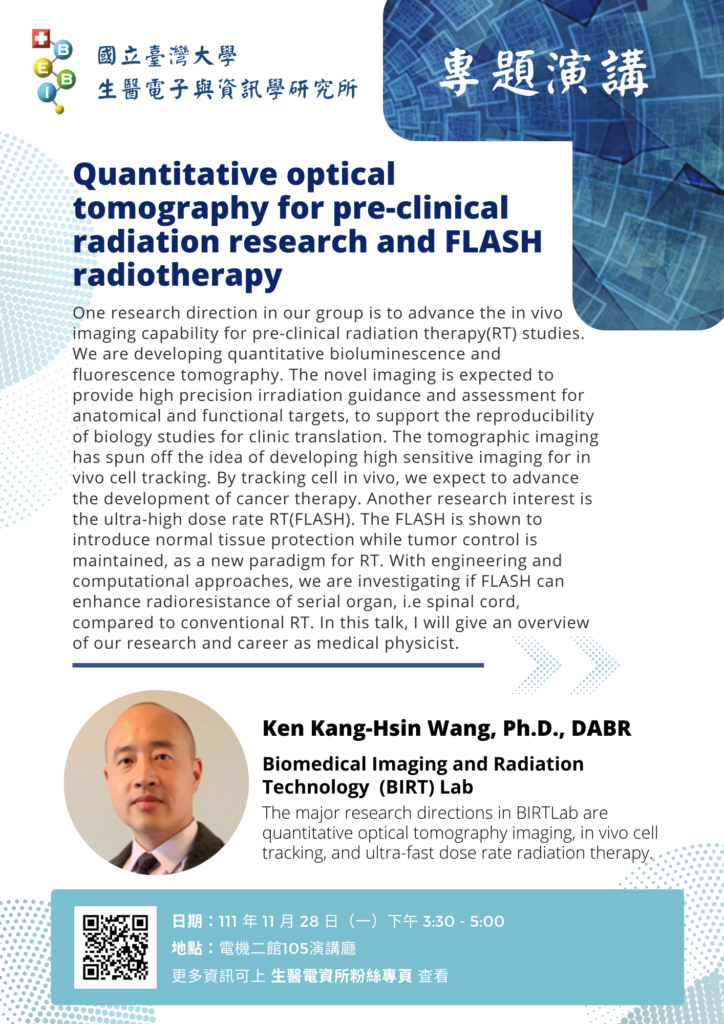◆專題演講公告◆
|時間:111年11月28日(一)下午3:30-5:00
|地點:電機二館105演講廳
|講者:Ken Kang-Hsin Wang, Ph.D., DABR
|主題:Quantitative optical tomography for pre-clinical radiation research and FLASH radiotherapy
|摘要:One research direction in our group is to advance the in vivo imaging capability for pre-clinical radiation therapy(RT) studies. We are developing quantitative bioluminescence and fluorescence tomography. The novel imaging is expected to provide high precision irradiation guidance and assessment for anatomical and functional targets, to support the reproducibility of biology studies for clinic translation. The tomographic imaging has spun off the idea of developing high sensitive imaging for in vivo cell tracking. By tracking cell in vivo, we expect to advance the development of cancer therapy. Another research interest is the ultra-high dose rate RT(FLASH). The FLASH is shown to introduce normal tissue protection while tumor control is maintained, as a new paradigm for RT. With engineering and computational approaches, we are investigating if FLASH can enhance radioresistance of serial organ, i.e spinal cord, compared to conventional RT. In this talk, I will give an overview of our research and career as medical physicist.
|講者簡介:Dr. Ken Wang received his B.Sc. in physics from the National Central University in Taiwan. His early research focused on theoretical condensed matter physics. He later pursued his Ph.D. in physics at the University of Rochester, NY. He devoted himself to the field of photodynamic cancer therapy for his Ph.D. studies and postdoctoral training at the University of Pennsylvania (UPenn). After his postdoctoral training, he continued his medical physics residency at the UPenn, where he later became the chief resident.
In 2012, Dr. Wang joined Johns Hopkins Hospital as a senior medical physicist and assistant professor. During his time at Hopkins, he made significant advances in optical tomography-guided radiation therapy for pre-clinical research. In recognition of the significance of his contributions, the NIH-NCI peer-review process has awarded him, within a short span of 1.5 years, a R21, a R37, and a R01 funding. It is worthwhile to note that the R37 is R01 equivalent funding and is so called the Method to Extend Research in Time (MERIT) Award which pertains to an early-stage investigator with outstanding grant proposal. The R37 is qualified for extended 7-year of support. He later established the biomedical imaging and radiation technology lab (BIRTLab). The goal is to translate laboratorial developments to the scientific community, providing investigators unprecedented research capabilities in seeking a cure for cancer. In 2020, Ken was recruited to UT Southwestern Medical Center(UTSW) as an associate professor in the Department of Radiation Oncology, with the awarded funding from State of Texas; CPRIT Scholar in Cancer Research Rising Star Award at $4 million.
The major research directions in BIRTLab are quantitative optical tomography imaging, in vivo cell tracking, and ultra-fast dose rate radiation therapy.

